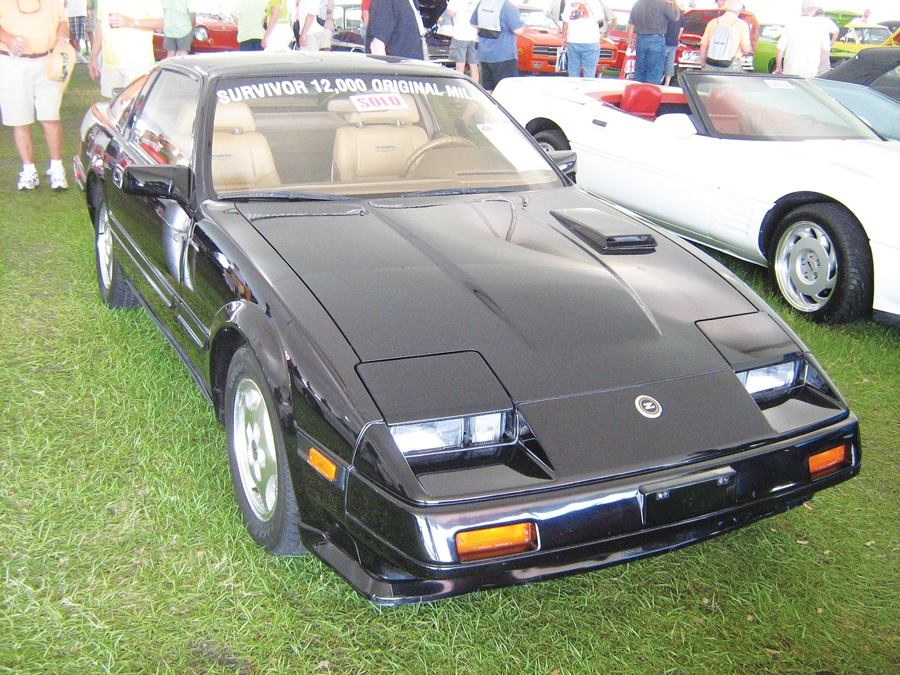
It’s almost an axiom of the automotive world that an unloved make or model can gain respectability over time. The reasons for this phenomenon are many —changing tastes and fashions can transform a formerly ugly duckling, or advancing technology and engineering may reveal that a particular car was ahead of its time. But mostly, when all the models around a particular car have appreciated enough, they’ll bring the less-loved units along with them — to an extent, anyway.
That may become the case with the mid-1980s Nissan/Datsun 300ZX (1984–89 Z31). Prices for the early edition Datsun Z-cars (1969–78 S30) have risen nicely over the past 10 years, and those cars are just now starting to be accepted at concours and classic-car events as fully qualified participants. The later-model Nissan 300ZX (1990–2000 Z32) has always received more respect for its substantially better looks and performance. So what can be said for the mid-year models?
After the initial run of the 240Z/260Z/280Z, Datsun produced the 280ZX (1979–83 S130) and then the Nissan/Datsun 300ZX.
The 300ZX debuted in late 1983 as a 1984 model, and used both the Nissan and Datsun names on its badge. In 1985, the venerable Datsun name was dropped forever. The 300ZX represents Nissan’s first foray into V6 power, and improved aerodynamics made the 300ZX an incremental performance upgrade over the preceding 280ZX model.
Apples to apples
The 1970–73 240Z is considered the gold standard for Z-cars, so let’s compare the two models by the numbers. Buyers of the naturally aspirated 300ZX got 160 horsepower — about 35 horsepower more than the actual net power of an original 240Z, and the turbo 300ZX kicked out an even 200 horsepower. Torque figures from the V6 were even better, with the naturally aspirated version delivering 174 net pound-feet and the turbo making 202 net pound-feet to the 240Z’s original 146 gross pound-feet.
Of course, that increase in engine power is counterbalanced by middle-aged weight gain. The original 240Z weighed in at a svelte 2,301 pounds, while the lightest two-seat 1984 300ZX tipped the scales at 2,783. If you ordered the 1984 Turbo, weight rose to a chunky 2,924 pounds. By the end of the line in 1989, the lightest 300ZX weighed 3,139 pounds, with only five additional horsepower to show for the extra bulk.
Looking outside the Nissan family tree, the 300ZX can be compared with the competing Toyota Supra Mark II and Mark III (1982–93), Porsche 944 (1982–91) and the first and second generation Mazda RX-7 (1978–91).
The 300ZX offered slightly better power than the Toyota through 1985, but then the new A70 chassis and 3.0-liter engine boosted the Supra’s base horsepower to 200, and the turbocharged Supra offered 230 horsepower — far outperforming the Nissan. The Mazda lagged a little bit in raw engine power, but not enough to take the rotary out of competition. The Porsche was competitive in every area except price.
The 1984 buyer considering the 300ZX was looking at a price tag from $15,799 to $18,199, with the difference depending primarily on the turbo. The base Supra was tagged at $15,074, the best of the first-generation RX-7s sold for $15,095, and the Porsche cost a princely $21,440. Today, every one of those cars has stood the test of time better than the 300ZX.
Finding the collectibility
As an Affordable Classic, there’s no denying the well-deserved affordability in the 300ZX, but finding the classic appeal is a tall order.
A total of about 219,000 300ZX and almost 50,000 300ZX Turbo models were built and sold during the life of the Z31 model. There are a lot of these cars out there in the world, and almost all of them have been beaten hard and neglected. In the Winter-Spring 2014 Pocket Price Guide, SCM rates these cars as Investment Grade F — with three stars to indicate that the current prices are fully realized. So what is the astute collector to think?
A scan of recent online auction sales shows that excellent, ultra-low-mileage Turbo cars can command a price of about $10,000, but if a seller wants more than $4,000, the 300ZX must have fewer than 50,000 original miles and be a solid #2 or better.
The answer is to focus on the most basic fundamentals. Before any noticeable appreciation can take place for the 300ZX, the vast majority of them need to land in the recycling bin.
In the meantime, if you’re going to buy a 300ZX, you need to take your time and buy the very best one that you can possibly find. It won’t cost much more than a lesser example. With those large production numbers and lackluster history, anything less than a perfect #1 car is headed nowhere but down. ♦